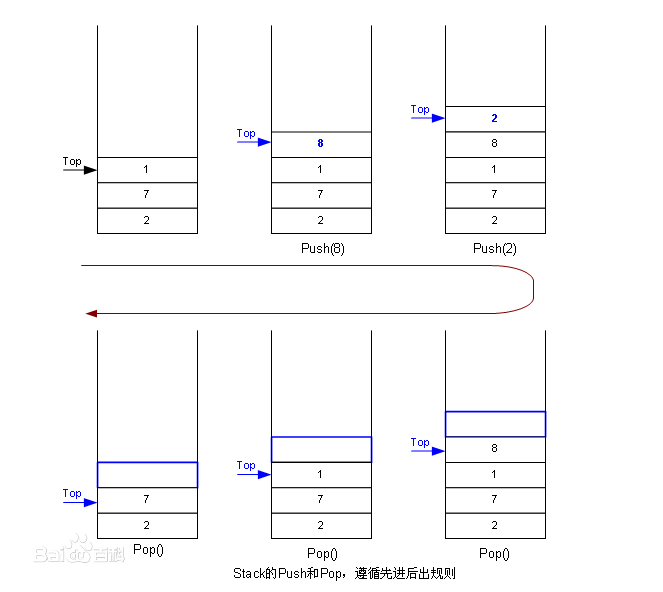概念
栈(stack)又名堆栈,它是一种运算受限的线性表。其限制是仅允许在表的一端进行插入和删除运算。这一端被称为栈顶,相对地,把另一端称为栈底。向一个栈插入新元素又称作进栈、入栈或压栈,它是把新元素放到栈顶元素的上面,使之成为新的栈顶元素;从一个栈删除元素又称作出栈或退栈,它是把栈顶元素删除掉,使其相邻的元素成为新的栈顶元素。栈是先进后出,出栈与入栈操作均在一端进行。
本文使用数组实现栈、使用容器实现栈、使用链表实现栈、两个队列实现栈
数组实现栈
代码实现
package com.billJiang.stack;
import java.util.Arrays;
import java.util.EmptyStackException;
/**
* Created by billJiang on 2016/11/29.
* 用数组实现栈顶
*/
public class StackArray {
private Object[] array;
private int top;
private int size=3;
public StackArray(){
array=new Object[size];
top=-1;
}
public boolean isEmpty(){
return top==-1;
}
public Object pop(){
if(top==-1){
throw new EmptyStackException();
}
return array[top--];
}
public Object peek(){
if(top==-1)
return null;
return array[top];
}
public Object push(Object element){
if(top==size-1){
array= Arrays.copyOf(array,size*2);
}
array[++top]=element;
return element;
}
}
测试
package com.billJiang.stack;
/**
* Created by billJiang on 2016/11/29.
*/
public class StackArrayTest {
public static void main(String[] args) {
StackArray stack=new StackArray();
stack.push(new Integer(1));
stack.push(new Integer(2));
stack.push(new Integer(3));
stack.push(new Integer(4));
stack.peek();
stack.pop();
stack.push(new Integer(5));
}
}
容器实现栈
代码实现
package com.billJiang.stack;
import java.util.ArrayList;
import java.util.EmptyStackException;
import java.util.List;
/**
* Created by billJiang on 2016/11/30.
* 用ArrayList容器实现栈
*/
public class StackList<T> {
private List<T> list;
private int size;
public StackList(int size){
this.size=size;
list=new ArrayList<T>(size);
}
public T pop(){
if(this.isEmpty()){
throw new EmptyStackException();
}
return list.remove(list.size()-1);
}
public T peek(){
if(this.isEmpty()){
throw new EmptyStackException();
}
return list.get(list.size()-1);
}
public void push(T element){
list.add(element);
}
public boolean isEmpty(){
return list.isEmpty();
}
public int size(){
return list.size();
}
public boolean isFull(){
return list.size()==this.size;
}
}
链表实现栈
链表节点定义
package com.billJiang.stack;
/**
* Created by billJiang on 2016/11/30.
* 单向链表节点
*/
public class Node<T> {
private T item;
private Node<T> next;
public Node() {
this.item = null;
this.next = null;
}
public Node(T item, Node<T> next) {
this.item = item;
this.next = next;
}
public T getItem() {
return item;
}
public void setItem(T item) {
this.item = item;
}
public Node<T> getNext() {
return next;
}
public void setNext(Node<T> next) {
this.next = next;
}
}
代码实现
package com.billJiang.stack;
import java.util.EmptyStackException;
/**
* Created by billJiang on 2016/11/30.
* 使用单项链表实现栈,出栈、入栈均在一头进行
*/
public class StackLinkedList<T> {
private Node<T> top;
public void push(T element) {
if (isEmpty()) {
top = new Node(element, null);
}
Node<T> node = new Node(element, top);
top = node;
}
public T pop() {
if (isEmpty())
throw new EmptyStackException();
T element = top.getItem();
top = top.getNext();
return element;
}
public T peek() {
if (isEmpty())
throw new EmptyStackException();
return top.getItem();
}
public boolean isEmpty() {
return top == null;
}
}
两个队列实现栈
代码实现
思路:入栈在一个队列中进行,出栈时,将队列中其他元素移动另一个队列,剩下一个元素出队列,即出栈。
package com.billJiang.stack;
import com.billJiang.queue.QueueArray;
/**
* Created by billJiang on 2016/12/1.
* 两个队列实现栈
*/
public class StackQueue<T> {
private QueueArray<T> queue1;
private QueueArray<T> queue2;
private int maxLength;
public StackQueue(int initial) {
this.maxLength = initial;
queue1 = new QueueArray<>(initial);
queue2 = new QueueArray<>(initial);
}
public boolean push(T element) {
if (size() == maxLength) {
return false;
}
if (queue2.isEmpty())
queue1.put(element);
else
queue2.put(element);
return true;
}
public T pop() {
if(queue1.isEmpty()){
while(queue2.size()>1){
queue1.put(queue2.poll());
}
return queue2.poll();
}else{
while(queue1.size()>1){
queue2.put(queue1.poll());
}
return queue1.poll();
}
}
public T peek() {
T obj=null;
if(queue1.isEmpty()){
while(queue2.size()>0){
obj=queue2.poll();
queue1.put(obj);
}
}else{
while(queue1.size()>1){
obj=queue1.poll();
queue2.put(obj);
}
}
return obj;
}
public int size() {
return queue1.size() + queue2.size();
}
}

























 506
506

 被折叠的 条评论
为什么被折叠?
被折叠的 条评论
为什么被折叠?








